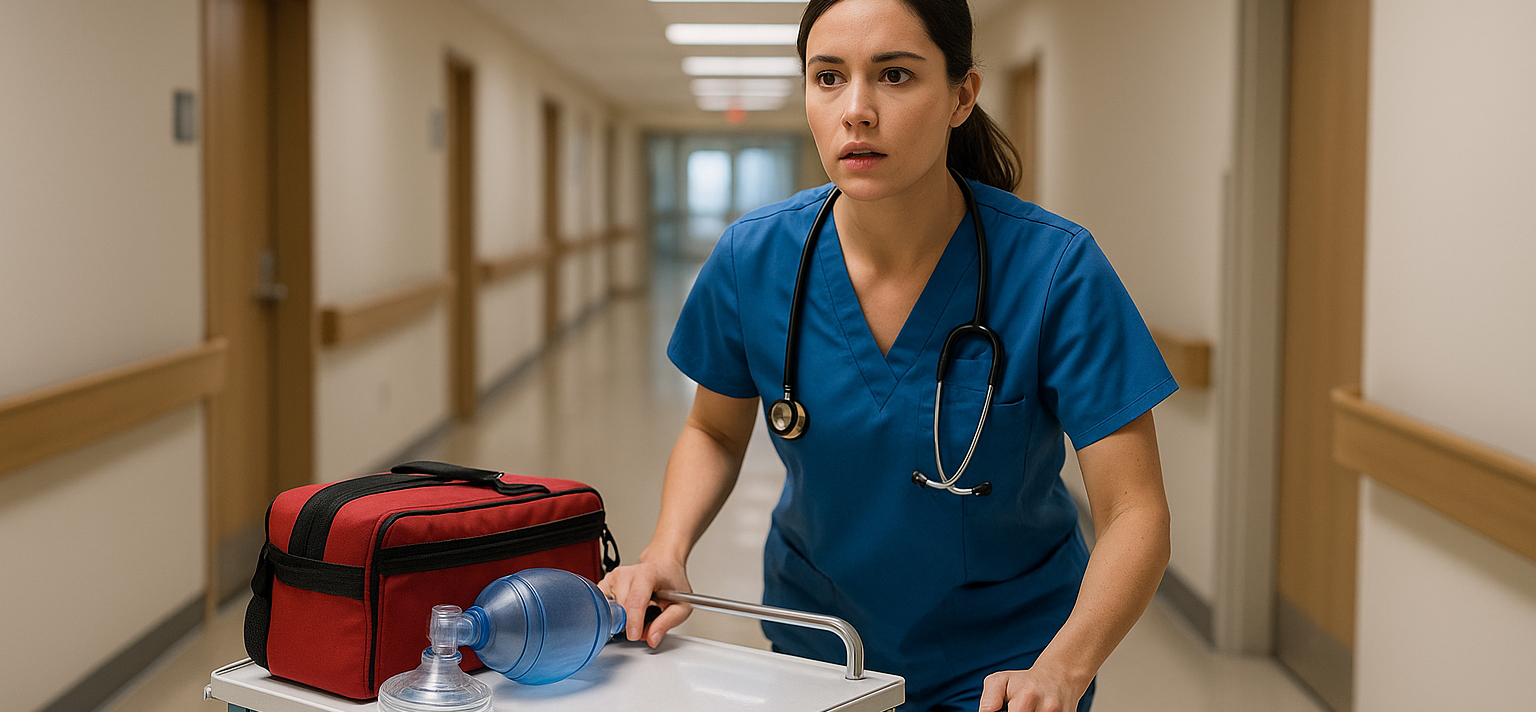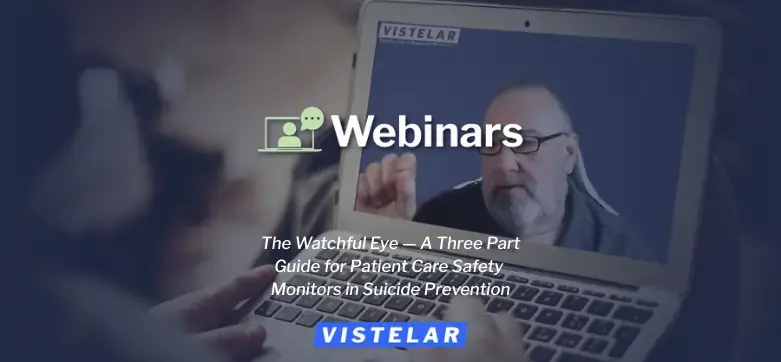This article is Part 3 of a three-part series on the importance of Patient Care Safety Monitors. Click here to read Part 1, or click here to read Part 2.
Every second counts in a suicide prevention crisis. For Patient Care Safety Monitors, knowing exactly what to do—and staying mentally and emotionally prepared to do it—can be the difference between life and loss. This final article explores how Patient Care Safety Monitors can respond effectively to suicidal behavior, take care of themselves during high-stress shifts, and build habits that keep their response sharp and reliable. These practices form the foundation for healthcare workplace violence prevention, nurse safety training, and effective behavioral health crisis intervention programs.
Vistelar’s First Responder Philosophy
At the core of effective crisis intervention is Vistelar’s 10-step protocol—a practical framework to help Patient Care Safety Monitors act decisively and safely during a suicide attempt: 
- Arrive Quickly
- Access the Scene Safely
- Activate Alarms or Code System
- Evaluate Immediate Risk
- Enter When Safe
- Stabilize the Situation
- Check Medical Status
- Monitor Ongoing Risk
- Communicate with the Care Team
- Document and Debrief
This system, based on decades of front-line crisis experience, helps Patient Care Safety Monitors remain focused, reduce hesitation, and coordinate with healthcare teams under pressure. Aligning with American Heart Association (AHA) recommendations for basic life support and early response, this step-by-step plan bridges emotional readiness with lifesaving action. It also reinforces structured response models emphasized in healthcare staff training for handling violent situations and emergency department conflict resolution.
Scenario Walkthrough: A Cord Around the Neck
Scenario: A patient wraps a phone cord around their neck in their room.
- Arrive: The Patient Care Safety Monitor, Jordan, hears gasping through the door and rushes to respond.
- Access: Jordan ensures the hallway is clear and calls a code while alerting nearby staff.
- Alarm: He hits the call button and triggers the local emergency protocol.
- Evaluate: Jordan sees the patient conscious but struggling.
- Enter: He enters with a nurse while maintaining verbal contact—“I’m here to help you.”
- Stabilize: He gently removes the cord while the nurse assesses vitals.
- Medical Check: The patient is moved to observation with oxygen support.
- Monitor Long-Term: Jordan continues 1:1 monitoring for 24 hours.
- Communicate: He uses the SBAR model (Situation, Background, Assessment, Recommendation) to brief the charge nurse.
- Document/Debrief: He records exact actions taken and participates in a short debrief with the unit supervisor.
This structured response not only protects the patient—it creates a timeline that satisfies Joint Commission Sentinel Event Alert 56 on detecting and treating suicide ideation. This approach exemplifies best practices in clinical de-escalation techniques, trauma-informed communication, and healthcare conflict management under crisis conditions.
Drills Save Lives
Studies show that routine simulation improves suicide response accuracy by over 40% (Coffey et al., Journal of Patient Safety, 2021).
We recommend a daily five-minute tabletop drill:
- Staff verbalize their 10-step response to a hypothetical situation.
- Supervisors rotate through “curveball” scenarios weekly.
- Notes from the drill can be used for quality assurance tracking.
Practicing under low-stress conditions hardwires calm, confident action when the real thing hits. Routine simulation also supports violence prevention programs for healthcare workers and continuous readiness training across hospital teams.
Self-Care Isn’t Optional
Working near suicide risk takes a toll. And unlike machines, humans don’t operate well under constant strain. Patient Care Safety Monitors must treat their own self-care with the same seriousness they give to patient care. As noted by Harvard Health, controlled breathing techniques—like the 4-7-8 method—help regulate cortisol and calm the nervous system.
Daily Self-Care Checklist:
- Hourly Stress Rating (1–5)
- 4-7-8 Breathing Every Break
- Drink 8 oz. Water Every 2 Hours
- Quick Body Scan to Loosen Muscles
- Post-Shift Peer Debrief (5–10 min)
Debriefing with co-workers helps prevent secondary trauma, supported by the International Critical Incident Stress Foundation (ICISF). This peer support model enhances team resilience and supports healthcare staff training for handling violent situations and behavioral health crisis intervention.
Recognizing Burnout and Asking for Help
Signs of compassion fatigue are often overlooked until serious harm sets in. If you notice:
- Feeling emotionally numb
- Snap irritability
- Poor sleep or nightmares
- Avoiding patient interaction
- Loss of empathy
…you may be experiencing burnout. It’s critical to talk to your supervisor or use your facility’s Employee Assistance Program (EAP). Early intervention restores balance before physical or psychological damage occurs.
The CDC Ergonomic Guidelines also remind us that the body is as much at risk as the mind—supportive footwear, proper hydration, and break management are vital. Physical well-being plays a direct role in maintaining focus and empathy—both essential components of nurse safety training and healthcare workplace violence solutions.
Quick Reference: Red Flag Behaviors
| Behavior | Immediate Action |
| Giving away belongings | Notify charge nurse and document verbatim |
| Flat affect, long stare | Engage with open-ended question and observe |
| Hiding cords/items | Search area with clinical staff present |
| Self-harm statements | Activate suicide protocol, quote exact words |
| Withdrawal or no eye contact | Increase observation level, communicate to team |
Each of these behaviors can signal rising risk. Recognizing and responding early allows Patient Care Safety Monitors and care teams to take immediate action—reinforcing trauma-informed care and patient-centered prevention practices.
Final Words
“By treating your own well-being as a safety priority, you maintain the clarity, empathy, and stamina required to protect patients in crisis.”
Crisis readiness starts with mindset, continues through structured response, and is sustained through regular self-checks. When Patient Care Safety Monitors train like responders, care like professionals, and recover like survivors, they don’t just witness safety—they create it.
References:
- American Heart Association: BLS Guidelines
- Joint Commission: Sentinel Event Alert 56
- Harvard Health: Breath Control Techniques
- ICISF Peer Support Guidelines
- AHRQ SBAR Toolkit
- CDC Ergonomic Guidelines
- Coffey, M. et al. Simulation Training Study
This article is Part 3 of a three-part series on the importance of Patient Care Safety Monitors. Click here to read Part 1, or click here to read Part 2.









.png)